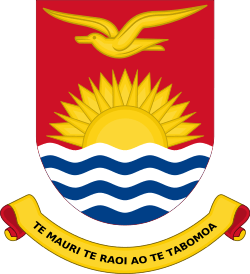Constitution of Kiribati
The Constitution of Kiribati is the supreme law of Kiribati, which was promulgated in 1979, and was amended in 1995, in 2016, and in 2018.
 |
|---|
| This article is part of a series on the politics and government of Kiribati |
|
This constitution sets out the principles of the Bill of Rights and the protection of the Fundamental Rights and Freedoms of the individual.[1][2][3]
History
In 1977, John Hilary Smith, British Governor of the Gilbert Islands, reunites a Constitutional Convention of 150 members.
Kiribati's independence has been granted by the United Kingdom by virtue of the Kiribati Independence Order 1979 (UK)[4] and the Republic of Kiribati became an independent constitutional republic as sovereign and democratic state, and the 41st member of the Commonwealth of Nations, on 12 July 1979.
Structure
The Constitution is divided into 10 chapters and 2 schedules.[5]
References
- Jersey Law Commission
- "The Constitution of Kiribati (English)" (PDF). PACLII. Retrieved 2 August 2020.
- "Constitution of Kiribati". Kiribati: Constitution and Politics. Retrieved 2 August 2020.
- "Constitution of Kiribati 1979, as amended to 1995". Global Gender Equality Constitutional Database. UN Women. Retrieved 10 May 2020.